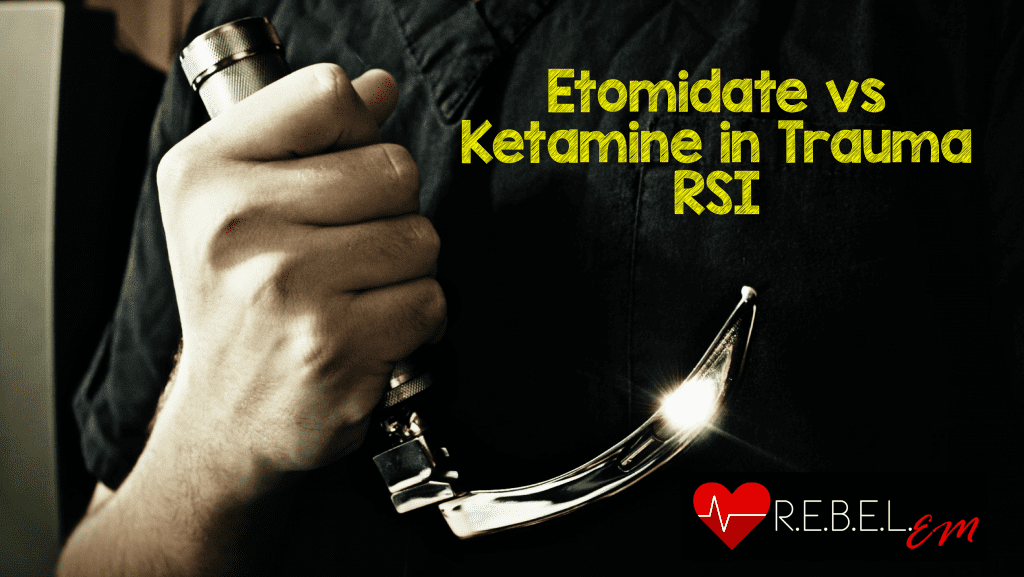
 Background: Etomidate and ketamine are both routinely used as induction agents during rapid sequence intubation (RSI) in trauma patients. It is well established that etomidate transiently suppresses the adrenal gland through inhibition of the 11-beta hydroxylase enzyme. Though adrenal suppression in theory can cause deleterious outcomes, there is no high-quality evidence demonstrating a change in patient centered outcomes with it’s use in comparison to alternate agents. Ketamine has long been an alternative induction agent to etomidate but historical concerns, though disproven in more recent literature, limited it’s use due to concerns over increasing intracranial pressure.
Background: Etomidate and ketamine are both routinely used as induction agents during rapid sequence intubation (RSI) in trauma patients. It is well established that etomidate transiently suppresses the adrenal gland through inhibition of the 11-beta hydroxylase enzyme. Though adrenal suppression in theory can cause deleterious outcomes, there is no high-quality evidence demonstrating a change in patient centered outcomes with it’s use in comparison to alternate agents. Ketamine has long been an alternative induction agent to etomidate but historical concerns, though disproven in more recent literature, limited it’s use due to concerns over increasing intracranial pressure.
Etomidate vs Ketamine in Trauma RSI
Article:
- Upchurch CP et al. Comparison of etomidate and ketamine for induction during rapid sequence intubation of adult trauma patients. Ann Emerg Med 2017; 69: 24-33. PMID: 27993308
Clinical Question: Is hospital mortality in trauma patients requiring ED intubation associated with the choice of induction agent (i.e. etomidate vs. ketamine)?
Population: Adult patients > 18 years of age who presented with acute trauma and were intubated in the ED with either etomidate or ketamine.
Intervention: During the 1st half of the study, etomidate was the “on-protocol” induction agent. During the second half of the study, ketamine replaced etomidate as the “on-protocol” induction agent.
Control: No Control
Outcomes:
- (Primary): Hospital mortality (death in the ED or during index hospitalization after RSI in the ED)
- (Secondary): ICU-free days (within the first 28 days), days alive and free of invasive mechanical ventilation, days alive and free of vasopressor support, units of PRBCs transfused over the first 48 hours, hospital-acquired sepsis within 28 days, time to hospital discharge, hazard of hospital death.
Design: Retrospective, before and after, chart review at a single, academic, level 1 US trauma center.
Excluded: Exclusion criteria were not explicitly discussed in the methods but can be gleaned from figure
- Receiving either drug pre-hospital
- Use of another agent
- No induction agent used
- Age < 18
- Unknown induction agent
- Both etomidate and ketamine used
Primary Results:
-
968 patients identified retrospectively for analysis
-
Received etomidate
- 526/968 (54%)
- 34/396 (8.6%) of patients in the “ketamine period” received etomidate
-
Received ketamine
- 442/968 (46%)
- 42/508 (8.3%) of patients in the “etomidate period” received ketamine
-
Received etomidate
-
Median dosing
- Etomidate: 20 mg
- Ketamine: 150 mg
- Total hospital mortality: 181/968 (18.7%)
Critical Findings:
-
Hospital Mortality (primary outcome)
- Etomidate: 91/526 (17.3%)
- Ketamine: 90/442 (20.4%)
- Adjusted Odds Ratio = 1.41 (95% CI: 0.92 – 2.16)
- No statistically significant difference
-
Secondary Outcomes
- Hospital-acquired sepsis: OR 0.72 (95% CI 0.52 – 0.99) favoring ketamine
- Vasopressor-free days: OR 0.74 (95% CI 0.58-0.95) favoring etomidate
- No differences in any other secondary outcome
Strengths:
- Study asked an important clinical question with a patient centered outcome
- Given inherent difficulties with performing a RDCT in critical trauma patients, this methodology may be the best we see
- Baseline patient characteristics were similar between groups
- Incomplete data was only present on 5 patients who met inclusion criteria
Limitations:
- The study was not prospective, was not randomized and was not blinded. This introduces significant bias and limits the data to showing association and not causation.
- The study was conducted at a single, US, level 1 trauma center making external validity questionable
- Due to the retrospective methodology, important confounders may have been missed which could drastically effect the outcomes.
- Due to the retrospective nature of this study, we cannot determine why one agent was chosen over the other (~ 8% of patients received non-“on protocol” drug)
- A before and after study design introduces issues of temporal changes in practice that may have affected patient outcomes independent of the choice of agent
- Mean drug dosing reflects standard RSI dosing of each medication (etomidate 0.3 mg/kg, ketamine 1-2 mg/kg). Lower dosing of induction agent is encouraged in unstable patients and may affect outcome but granular data on dosing and outcomes not available in this data set
Other Issues:
- About 1/3 of patients overall had traumatic brain injury (TBI). Although the idea that ketamine has detrimental effects in this group has been largely debunked, any deleterious effects in this study may have been diluted.
Authors Conclusions:
“In this analysis spanning an institutional protocol switch from etomidate to ketamine as the standard rapid sequence intubation induction agent for adult trauma patients, patient-centered outcomes were similar for patients who received etomidate and ketamine.”
Our Conclusions:
This study found no association between induction agent used for RSI (ketamine or etomidate) and in-hospital mortality. A prospective, RDCT should be undertaken to confirm or refute these findings.
Potential to Impact Current Practice:
At this point, clinicians should feel free to use whichever induction agent they prefer until better evidence becomes available.
Clinical Bottom Line:
Based on the best available evidence, it does not appear that induction with either ketamine or etomidate is superior to the other in terms of mortality in trauma patients requiring ED RSI.
References:
- Upchurch CP et al. Comparison of etomidate and ketamine for induction during rapid sequence intubation of adult trauma patients. Ann Emerg Med 2017; 69: 24-33. PMID: 27993308
Post Peer Reviewed By: Salim Rezaie (Twitter: @srrezaie)
The post Etomidate vs Ketamine in Trauma RSI appeared first on REBEL EM - Emergency Medicine Blog.
